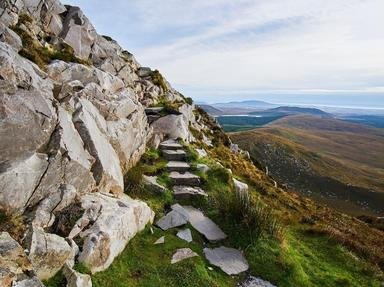Quiz Answer Key and Fun Facts
1. The first major rebellion in Ireland in modern times began in County Wexford in 1798. One of its leaders was a Catholic priest, Father John Murphy. Which song about Father Murphy contains these lines: "Look out for hirelings, King George of England / Search every kingdom that breeds a slave . . .?"
2. The Wexford rebellion is the subject of many tunes. Robert Dwyer Joyce wrote a song that begins: "I sat within a valley green, I sat me with my true love / My sad heart strove to choose between, the old love and the new love." What was is the name of this famous song?
3. The Wexford rebellion soon spread to the north and west of Ireland. "Oh, see the fleet-foot hosts of men, who speed with faces wan / From farmstead and from fisher's cot, along the banks of Bann." Who is the hero of this rousing song?
4. In August, 1798 a French invasion force under the command of General Jean Humbert landed in County Mayo. What is the name of the song commemorating this event that begins: "When you honor in song and in story, the names of the patriot men / Whose valor has covered with glory, full many a mountain and glen?"
5. Only five years after the Rebellion of 1798 was crushed, the Irish launched another bid for freedom in 1803. Which of these songs honors the leader of the 1803 rising?
6. This song, also known as "Down By the Glenside," begins: "'Twas down by the glenside, I met an old woman / She was picking young nettles, and she scarce saw me coming / I listened a while to the song she was humming . . ." What is the name of this song, which honors the men who led a rebellion against England in 1867?
7. The Irish War of Independence dates from the Easter Rebellion of 1916. One of the best songs commemorating this crucial event in Irish history begins: "It was down the glen one Easter morn, to a city fair rode I / And Ireland's lines of marching men in their squadrons passed me by . . ." What is the name of this haunting ballad?
8. One of the saddest stories to come out of the Easter Rebellion is that of Joseph Mary Plunkett. Just before he was executed, he married his sweetheart in the prison chapel. Frank and Sean O'Meara wrote a beautiful and touching song about her. What was her name?
9. The Irish War of Independence was the source of many rousing songs. One begins: "From east to west, from north to south / They tried to hunt the column out . . ." What is the name of this song, that celebrates the deeds of one of Ireland's most famous guerrilla leaders?
10. Not all Irish rebel songs are sad or violent. Some are actually quite funny. One song (based on a true story) tells the tale of some IRA men who needed transportation. It begins "Twas down by Brannigan's corner, one morning I did stray / I met a fellow rebel, and to me he did say . . ." What is the name of this song, written by Willie Gillespie?
11. All countries need a national anthem. What song was officially adopted as Ireland's national anthem in 1926?
12. "Come listen all you true men to my simple rhyme / For it tells of a young man, cut off in his prime / A soldier and a statesman, who laid down the law / And died by the roadside in lone Beal na mBlath." Which Irish rebel is this song about?
13. "In Mountjoy Gaol, one Monday morning / High upon the gallows tree / _______ gave his young life / For the cause of liberty." Whose name goes in the blank?
14. One of my favorite songs begins: "Twas the feast of St. Patrick, at the dawn of the day / The hills of Tyrconnell stood somber and gray / The first light of morning illumined the sky / As four Irish heroes were led forth to die." What song recounts the death of four anti-Treaty soldiers in County Donegal in March, 1923?
15. Dominic Behan wrote this song about a young I.R.A. soldier, Feargal O'Hanlon, who was killed on New Year's Day, 1957 in an attack on a Royal Ulster Constabulary barracks in Brookeborough, County Fermanagh. Tom Clancy wrote a book that refers to this song. What is it?
Source: Author
daver852
This quiz was reviewed by FunTrivia editor
Bruyere before going online.
Any errors found in FunTrivia content are routinely corrected through our feedback system.
